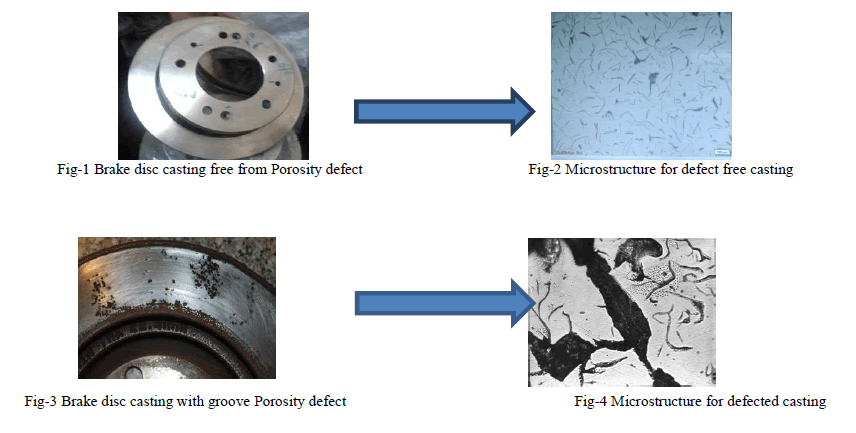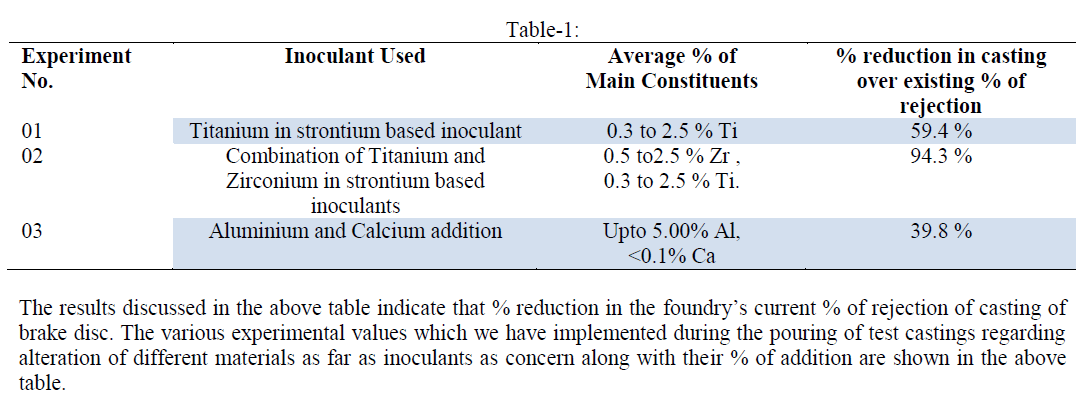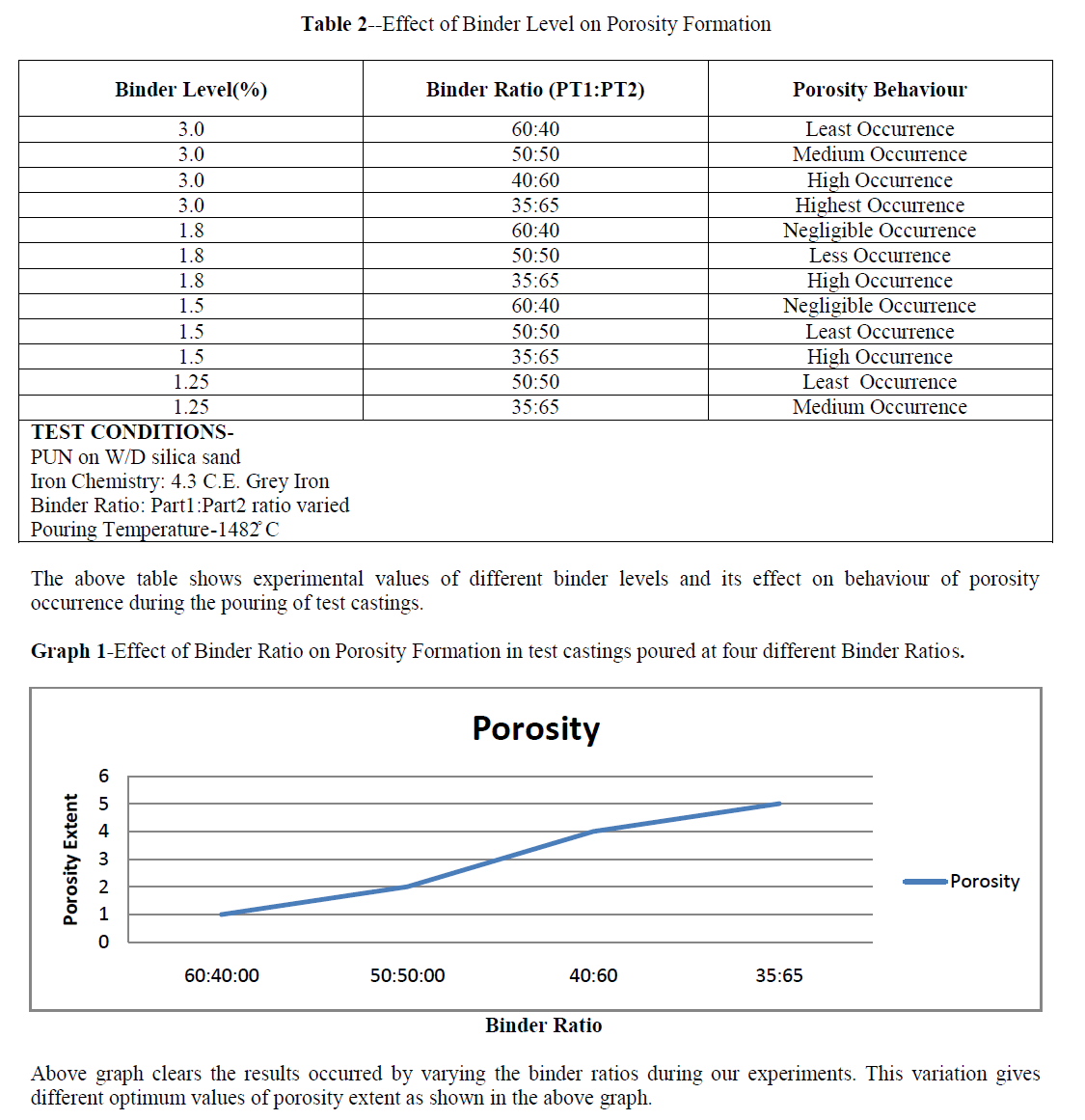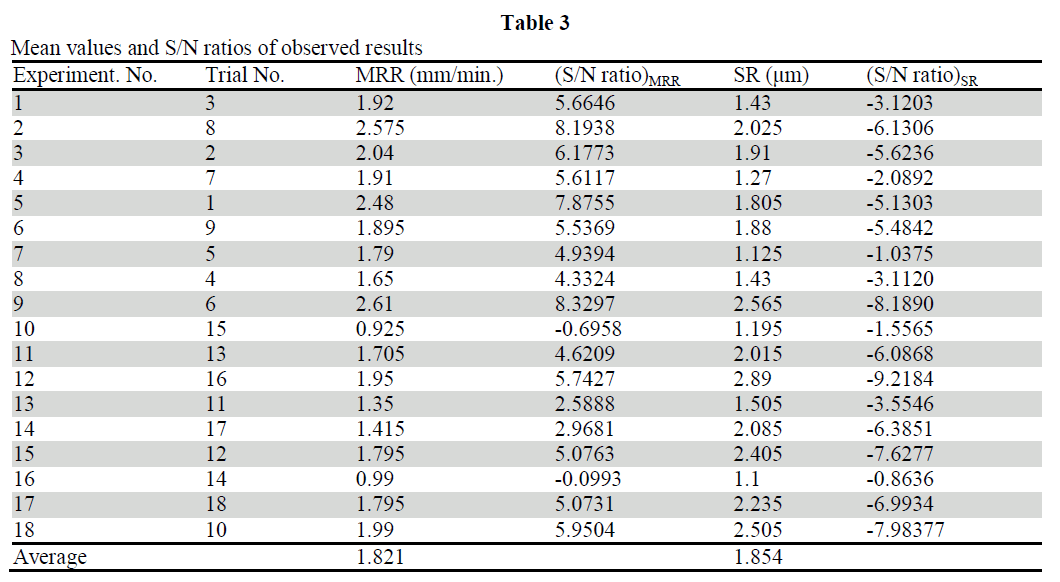ISSN ONLINE(2319-8753)PRINT(2347-6710)
ISSN ONLINE(2319-8753)PRINT(2347-6710)
| Ganapathy Srinivasan. R1, Mohanraj. L2, Prabhakaran. D3 Assistant Professor, Department of Mechanical Engineering, Magna College of Engineering, Magaral, Chennai, India |
| Related article at Pubmed, Scholar Google |
Visit for more related articles at International Journal of Innovative Research in Science, Engineering and Technology
In this paper, wire electrical discharge machining of WC-Co composite is studied. Influence of taper angle, peak current, pulse-on time, pulse-off time, wire tension and dielectric flow rate are investigated for material removal rate (MRR) and surface roughness (SR) during intricate machining of a carbide block. In order to optimize MRR and SR simultaneously, grey relational analysis (GRA) is employed along with Taguchi method. Through GRA, grey relational grade is used as a performance index to determine the optimal setting of process parameters for multiple machining characteristics. Analysis of variance (ANOVA) shows that the taper angle and pulse-on time are the most significant parameters affecting the multiple machining characteristics. Confirmatory results, proves the potential of GRA to optimize process parameters successfully for multi-machining characteristics.
Keywords |
| ANOVA, WC – CO, MRR |
INTRODUCTION |
| The cemented carbides such as WC-Co are typically used in tool and die industries because of their excellent hardness and strength. It is hard to machine material, produced by sintering of WC powder with the binder (typically Co or Ni) at temperature near the melting point of the metal (Kim et al., 2005). The formation of liquid phase during sintering enhances the densification process and hence increases the hardness of the composite. |
| Mach inability of WC-Co composite is very important in die and tool manufacturing as it may affect different manufacturing phases including product design, process planning, machining operations etc. Processing of WC-Co composite is very difficult with conventional machining method due to its high hardness. Machining of WC-Co, using CBN tools in CNC turning, results in very high cutting forces and very poor surface finish (Liu et al., 200) . Ultrasonic machining method (Nath et al., 2009) may yield better machining results as compared to conventional machining process but complex and precise shapes are very difficult to generate. Similar difficulties occur with grinding operation. |
| Electrical discharge machining (EDM) method is the best alternative to machine hard and non-conductive composites (Kucukturk & Cogun, 2010). Wire electrical discharge machining (WEDM) is a special form of EDM, which has the capability to produce intricate shapes and profiles in composite materials with a high degree of accuracy. In WEDM, the erosion mechanism is described as melting and/or evaporation of the surface material by the heat generated in the plasma channel. |
| Therefore, discharge energy tends to melt, evaporate and remove cobalt even before the melting of WC. As a result, the WC grains may be released without melting and hence causes unstable machining (Saha et al., 2008). |
| In order to achieve an efficient process planning in machining of WC-Co composite into desired shape, we need accurate machinability data. Jangra et al. (2011) evaluated the effect of various factors and their sub-factors on machinability of WC- Co composite with WEDM using digraph and matrix method. They broadly grouped these factors into work material, machine tool, tool electrode, cutting conditions and geometry to be machined where machinability is measured in terms of material removal rate (MRR). |
| They concluded that the machine tool is the most influencing factor affecting the machinability of WC-Co composite. Low cobalt concentration and small grain size favours the high MRR. In case of cutting conditions, good conductivity and high flow rate of distilled water results in high MRR. |
II. EXPERIMENTAL SET UP, DESIGN AND RESULTS |
2.1 Experimental set up |
| I n this study, intricate machining of WC-Co composite wa s performed as shown in Fig. 1. WC- Co composite h aving 6% cobalt was taken as a work mater ial in the f orm of rectangular block of t hickness 13 mm. The d ensity and hardness of die materia l was meas ured as 14.95 g/cm3 a nd 77 H RC, respectively. The experiments were perfo rmed on 5 -axis sprint cut (ELPLUS-40) wire-EDM m anufactured by Electronica Machin e Tool Ltd, India. The range of variable parameters in sprint cut m achine tool were as follows: peak current, 10-230 amp.; pulse-on time, 100- 131μs; pulse-off time, 0-63μs; wire speed, 1-15 m/min.; wire tension, 1-15N; servo voltage, 10 -90 V; diele ctric flow rate 0- 12 litre per minute (LM-1). Zinc co ated brass w ire of diam eter 0.25 m m was used as an elec trode because of its good capab ility to sustain high dis charge energ y. |
 |
2.2 Experimental design |
| In present work, six process parameters namely peak current, pulse-on time, pulse-off time, wire tension, dielectric flow rate and taper angle were selected as input variables during intricate cutting of WC-%6Co composite with WEDM. The experiments were carried out with fixed value of servo voltage at 30V and distilled water was used as a dielectric fluid with a conductivity of 20S. Out of six input parameters, taper angle, which is a geometrical variable was kept at two levels while all five variables were assigned values of three levels. Taper angle was considered to provide some draft angle keeping in mind the concept of die and punch manufacturing. Preliminary experiments were conducted to select the range and values of the machining parameters. These results were discussed by Jangra et al. (2011) in section 5. Table 1 depicts the values of levels of the selected process variables. As the thickness of workpiece material is low (13 mm), therefore, feed rate (or downward movement) of wire was kept constant at a value of 8 m/min. Wire offset was taken at zero value. |
 |
| The orthogonal array forms the basis for the experimental analysis in the Taguchi method. The selection of orthogonal array is concerned with the total degree of freedom of process parameters. Total degree of freedom (DOF) associated with six parameters is equal to 11 (1×1+5×2). The degree of freedom for the orthogonal array should be greater than or at least equal to that of the process parameters. Thereby, a L18 orthogonal array having degrees of freedom equal to 17 has been considered in present case. The experimental layout is shown in Table 2. |
 |
2.3 Experimental results |
| Based on the experimental layout depicted in Table 2, the experiments were performed in random order and each specific experiment was repeated two times. Two machining characteristics namely material removal rate (MRR) and surface roughness (SR) were measured. MRR was measured in mm/min. which was observed from machine tool monitor screen. SR value (in μm) was measured in terms of mean absolute deviation (Ra) using the digital surface tester Mitutoyo 201P. Observed machining characteristics are depicted in Table 3. |
 |
III. OPTIMIZATION OF INDIVIDUAL MACHINING CHARACTERISTICS |
| In Taguchi method, the basic method converts the objective parameters to signal-to-noise (S/N) ratio treated as the quality characteristics evaluation index. The least variation and the optimal design are obtained by means of the S/N ratio. The higher the S/N ratio, the more stable the achievable quality. Depending on the required objective characteristics, there are three types of S/N ratio- the lower- the-better, the higher-the-better and the nominal-the-better. In present work, two types of S/N ratio has been used; Higher-the-better for MRR and lower-the-better for SR. |
| The S/N ratio with a higher-the-better characteristic that can be expressed as follows |
 |
| where yij is the ith experiment at the jth test and n is the total number of tests. Table 3 shows the S/N ratios of measured mean values of MRR and SR. |
| The response table using Taguchi method is employed here to calculate the effect of each level of process parameter on machining characteristics. It is done by sorting the mean values of machining characteristics corresponding to levels of the process parameter in each column of the orthogonal array, and taking an average on those with same level. For example, the average effect on MRR for parameters A and B at level 1 can be calculated as follows: |
| A1 = (1.92 + 2.575 + 2.04 + 1.91 + 2.48 + 1.895 + 1.79 + 1.65 + 2.61)/9 = 2.097, B1 = (1.92 + 2.575 + 2.04 + 0.925 + 1.705 + 1.95)/6 = 1.853. |
| Using the same method, calculations were performed for each process parameters level and the response Tables were generated for MRR and SR as shown in Table 4. |
 |
3.1 Predicted optimal results |
| In order to predict the optimal values of the machining characteristics, only significant parameters are included which were found utilizing analysis of variance (ANOVA). The optimal values are predicted using the following relationship, |
 |
| where η is the total mean of the machining characteristic under consideration; η is the mean values at the optimum level (from response Tables) and q is the number of process parameters that significantly affects the machining characteristics. |
IV. SUMMARY OF RESULTS |
| Using Taguchi method, process parameters were optimized individually for MRR and SR. The percentage error between experimental values and predicted results are less than 4% for both machining characteristics. Therefore, process parameters are successfully optimized for individual characteristics using Taguchi method. The optimal setting of process parameters for multiple machining characteristics, using GRA is A1 B3 C1 D2 E2 F3. Using ANOVA, two process parameters namely taper angle (A), pulse-on time (C) were found significant affecting the grey relational grade, significantly. The percentage error between experimental values and predicted values for MRR and SR using GRA are 2.2 and 0.35 respectively. Therefore, using GRA, process parameters can be successfully optimized for multiple machining characteristics during WEDM of WC-6%Co composite. Table 13 summarizes the results for individual and multiple machining characteristics. |
V. CONCLUSIONS |
| In present work, wire electrical discharge machining (WEDM) for WC-Co composite has been studied. Grey relational analysis (GRA), along with Taguchi method were used to optimize the material removal rate (MRR) and surface roughness (SR), simultaneously. Based on the results and discussions, the following conclusions are made: |
| • Using Taguchi method, MRR and SR were optimized individually. Two different optimal settings of process parameters were found for MRR and SR. The optimal predicted values for MRR and SR are 2.52mm/min. and 0.88μm. Using ANOVA on experimental results, three process parameters namely taper angle (A), pulse-on time (C) and pulseoff time (D) were found the most significant affecting the MRR and SR under 95% confidence level. |
| • In case of GRA, grey relational grade was used as a performance index to determine the optimal combination of process parameters for multiple machining characteristics. Equal weights were assigned to both the machining characteristics in calculating the grey relational grade. However, with a different set of weights, a different set of optimal parameters for machining characteristics will result. The optimal set predicted will be closer to the optimal set predicted for single characteristic with the largest weight. |
| • Using ANOVA, only two parameters namely taper angle (A) and pulse-on time (C) were affecting the grey relational grade. The percentage error between experimental values and predicted values for MRR and SR using GRA are 2.2 and 0.35, respectively. Therefore, using GRA, process parameters can be successfully optimized for multiple machining characteristics during WEDM of WC-6%Co. The optimal combination of the process parameters, using GRA for multi-machining characteristics is set to A1 (30), B3 (120 ampere), C1 (108μs), D2 (40μs), E2 (8N) and F3 (10 LM-1). |
| • GRA can be extended to more number of machining characteristics, provided accurate weights for different characteristics to calculate grade values. Thus, the solutions from this method will be useful for tool manufacturer who are willing to search for an optimal solution of process parameters. |
References |
|